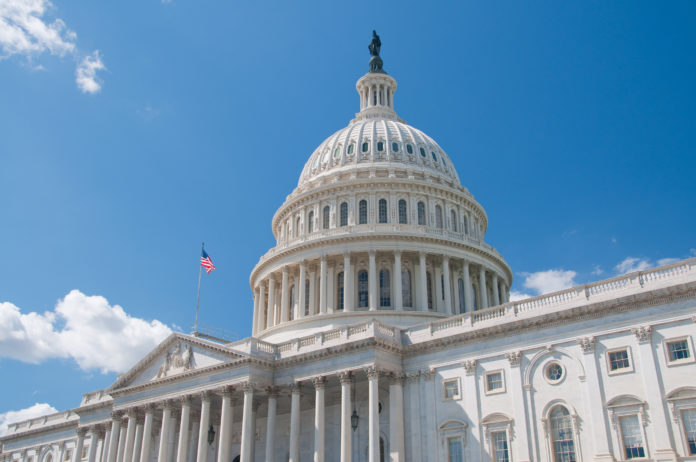Select each title below to read more:
Reconciliation Bill’s Proposed Medicaid Cuts Will Take Heavy Toll on Aging Services Providers, If Enacted
On May 11, the House Energy and Commerce Committee released legislation to fulfill their instructions for budget reconciliation. On April 10, the House passed a budget resolution previously passed by the Senate which formally kicked off the budget reconciliation process with topline instructions to several committees regarding how much money they had to save or were allowed to spend with via policy changes. The Committee will markup the bill on May 13.
The May 11 Energy and Commerce bill contains the policies that the Committee wants to advance under their instruction to cut $880 billion dollars in spending. The Congressional Budget Office (CBO) reported to Chairman Brett Guthrie (R-KY) on May 12 that the bill as drafted will exceed that target (which is allowable under reconciliation rules). In sum, the Committee’s bill would cut $916 billion in federal spending over 10 years, more than the $880 billion in spending cuts required by reconciliation instructions.
A majority of the bill’s cuts come from proposed changes to Medicaid. LeadingAge continues to analyze all of the details of the proposals laid out in the legislation. There are specific policies that we are concerned about and believe will have an impact on LeadingAge members and those they serve. We also believe that the policies, taken all together, represent dangerous cuts to the program. At least 8.7 million people are anticipated to lose coverage under the policies in this legislation, which is expected to cut upwards of $700 billion of federal spending from Medicaid over the next 10 years.
- Moratorium on nursing home staffing standard until Jan 1, 2035. This bill would put a moratorium on CMS imposing the nursing home staffing rule until Jan 1, 2035. The text of the legislation references the rule in its entirety, so we interpret this to include the enhanced facility assessment as well as the direct staffing components of the rule.
- Limit retroactive coverage to one month, down from the current three months. This provision in the bill would limit retroactive coverage in Medicaid to one month prior to the individual’s application date down from the current three months. This provision will impact nursing homes because nursing homes often take people on service who have not yet secured coverage – it takes time for families to gather the needed paperwork, to come to terms with the need to apply for Medicaid, and nursing homes may be left with more care uncompensated.
- Impose a moratorium on new or increased provider taxes. This provision would freeze provider tax arrangements where they are as of the date this legislation would be enacted. It prohibits states from establishing new provider tax arrangements. This provision would freeze provider taxes and the ensuing revenues at 2025 rates forever. LeadingAge is still reviewing this provision in more detail, but we believe it means that states also could not redirect the resources from the provider tax where they might be needed most. As a result, the taxes that are in place will become increasingly less meaningful as a mechanism to help states to respond to financial challenges that will arise from the policies in this bill as well as other external forces.
- Modify the criteria that the Department of Health and Human Services (HHS) must consider when determining whether healthcare related taxes are generally redistributive. This provision would change some of the rules around the waiver of the uniform tax requirement for health care taxes. It is intended to be targeted at managed care organization (MCO) taxes, but as drafted, it could be applicable to a broader set of health care taxes. Currently, MCO taxes in a number of states use the waiver to collect taxes based on the per member per month plans receive for the Medicaid population; this tax is not uniform across all lines of business for the health plan. If enacted, states could no longer get a waiver of uniformity and it is unlikely that the tax would be tolerated by the taxed class (in this case, the managed care organizations). This change would impact states’ ability to raise dollars for priorities across the long-term care space. Also on May 12, a proposed rule was released from the Office of Management and Budget that is looking at changing these policies via regulation as well; LeadingAge is comparing the legislative and regulatory approaches and will be commenting on the proposed rule.
- Revise the home equity limit for determining long-term care services under the Medicaid program. This section would establish a ceiling of $1,000,000 for permissible home equity values for individuals when determining allowable assets for Medicaid beneficiaries that are eligible for long-term care services. This section also prohibits the use of asset disregards from being applied to waive home equity limits. This policy will impact a wide variety of beneficiaries, including people from those in rural areas who may own valuable farms to those in states trying to make access to coverage easier by eliminating the asset limit as a marker of Medicaid eligibility.
- Work requirements (which the bill calls community engagement requirements). The bill would make work requirements mandatory for the expansion population. An individual would have to show that they are working at least 80 hours per month by completing at least 80 hours of community service, participating in a work program for at least 80 hours, enrolling in an educational program for at least 80 hours, or a combination of these activities.
- Section 1115 waivers. States use 1115 waivers as a tool to innovate in the Medicaid program by wrapping additional services around high-cost and aging populations. The bill would require demonstration projects under 1115 wavers to be cost neutral in the future.
There are a number of exemptions to the policies including, but not limited to, “individuals who are blind or disabled, who have a chronic substance use disorder, who have a serious and complex medical condition, or who have a condition, as defined by the State and approved by the Secretary, as meeting the definition of medically frail individuals who are already in compliance with the work requirements under the Temporary Assistance for Needy Families (TANF) program or Supplemental Nutrition Assistance Program (SNAP), individuals who are a parent or caregiver of a dependent child or an individual with a disability, or are incarcerated or recently released from incarceration within the past 90 days.” There is no built-in exception for family caregivers of older adults. States have to verify employment at least the month prior to the enrollment in Medicaid but can look back further than one month. States also do not have to enroll individuals while they are waiting to verify the paperwork.
We strongly believe, for example, that there are residents of HUD-assisted housing between the ages of 62-64 who are receiving Medicaid via the expansion eligibility pathway who will have to prove they qualify for an exemption or are in compliance with the community engagement requirement.
We are continuing to evaluate the bill in its entirety and will provide further updates to members. Overall, LeadingAge is very concerned about the combined impact of these policy changes on Medicaid beneficiaries, LeadingAge members, and state budgets.
“The policies in the bill represent dangerous cuts to Medicaid. Cuts at the federal level force states into impossible choices: reduce services, limit access, or slash provider payments. No matter the route, the result is the same: older adults, their families, and the providers who serve them, lose. We urge Congress to protect Medicaid and the aging services infrastructure that helps older Americans age with dignity, not desperation,” Katie Smith Sloan, president and CEO of LeadingAge, said in a May 12 statement on the bill.
LeadingAge Kansas is working on state specific talking points for the items that will most greatly impact seniors and providers. An action alert will be forthcoming.
Medicaid Provider Tax Proposed Rule Released
Late on May 12, the Centers for Medicare and Medicaid Services (CMS) posted a proposed rule to change parameters governing state use of provider taxes. The rule proposes realigning the use of provider taxes to ensure states develop tax structures that are generally redistributive. LeadingAge is reviewing the proposed rule and will provide analysis in the coming days, including a comprehensive overview and tools for response. Comments will be due 60 days from the date of publication in the Federal Register, which is expected on July 14. The proposed rule can be viewed here.
LeadingAge’s Deregulatory Comments to OMB
On May 12, LeadingAge responded to the Office of Management and Budget’s request for information on deregulation. Their comments span several agencies and call for the reversal or significant change to rules published in the Federal Register and codified in the Code of Federal Regulations. LeadingAge asked OMB to reverse rules from the Department of Health and Human Services related to home health, hospice, nursing home, and PACE providers. They asked the Department of Housing and Urban Development to do the same for affordable housing providers, and they seek similar deregulation from the Department of Labor and the Drug Enforcement Administration. LeadingAge also urges agencies not to finalize two proposed rules. LeadingAge is also submitting longer lists of sub regulatory change suggestions to federal agencies to streamline and better facilitate aging services compliance with statutory requirements. Participation in LeadingAge member Networks is a great way to share your ideas for streamlining. Read LeadingAge’s May 12 comments to OMB here.
House Republicans Unveil Budget Reconciliation Tax Package
In the mid-afternoon of May 12, Republican leaders of the House of Representatives Committee on Ways & Means released the complete text of proposed legislation relating to federal taxation. The Committee will formally mark up the package of proposals beginning May 13 at 1:30 PM CT. A cost estimate of the complete package was not immediately available, but the budget resolution passed in April instructs Ways & Means to spend a net $4 trillion on tax cuts in its package (or $4.5 trillion, depending on what spending cuts other committees enact in their legislation).
As expected, the plan extends 2017 tax cuts that benefit individual taxpayers but are set to expire at the end of 2025; and it creates new tax deductions designed to eliminate some federal income tax on tips beginning with tax year 2025, and on overtime for tax years 2025-2028, both of which are policies called for by President Trump. The package includes restoration of a provision that allows taxpayers who don’t itemize to take a limited deduction for charitable contributions, as well as positive modifications to the low-income housing credit, and we are pleased to find that it does not eliminate or reduce the municipal bond tax exemption. To help pay for the tax relief provisions within it, the plan also includes revenue raisers, including expanding the application of the existing tax on excess compensation within tax-exempt organizations; increasing excise taxes on the net investment income of private colleges and universities, and of certain private foundations with assets of $50 million or more; terminating a number of green-energy related tax credits; and – with respect to the Employee Retention Tax Credit – adding a concept of “ERTC promoter” to expand the scope of existing penalties for certain conduct that has taken place and permitting ERTC credits or refunds only for claims submitted on or before January 31, 2024. The Ways & Means bill also includes provisions to support and benefit the Low Income Housing Tax Credit program. LeadingAge will provide analysis of these and other provisions as soon as possible. In the meantime, a section-by-section summary is available here, and the bill language is available here.
Weekly Recaps: May 14, 2025
Affordable Housing Weekly Recap. Here is your weekly Affordable Housing Weekly Recap.
Home Health Weekly Recap. Home Health Weekly Recap.
Hospice Weekly Recap. Here is your weekly Hospice Weekly Recap.
Life Plan Community Weekly Recap. Here is your weekly Life Plan Community Recap.
Medicaid, HCBS, and PACE Weekly Recap. Here is your weekly Medicaid, HCBS, and PACE Weekly Recap.
Nursing Home Weekly Recap. Here is your Nursing Home Weekly Recap.




